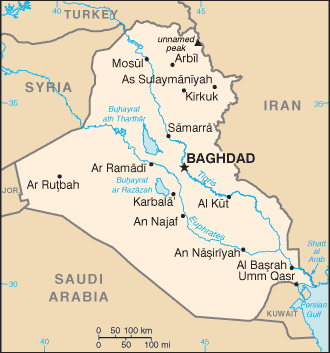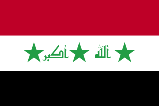Geography >> Middle East >> Iraq History and Timeline
Iraq
Capital: Baghdad
Population: 39,309,783
The Geography of Iraq
Borders: Syria, Turkey, Iran, Kuwait, Jordan, Saudi Arabia
Total Size: 437,072 square km
Size Comparison: slightly more than twice the size of Idaho
Geographical Coordinates: 33 00 N, 44 00 E
World Region or Continent: Middle East
General Terrain: mostly broad plains; reedy marshes along Iranian border in south with large flooded areas; mountains along borders with Iran and Turkey
Geographical Low Point: Persian Gulf 0 m
Geographical High Point: unnamed peak; 3,611 m; note - this peak is not Gundah Zhur 3,607 m or Kuh-e Hajji-Ebrahim 3,595 m
Climate: mostly desert; mild to cool winters with dry, hot, cloudless summers; northern mountainous regions along Iranian and Turkish borders experience cold winters with occasionally heavy snows that melt in early spring, sometimes causing extensive flooding in central and southern Iraq
Major Cities: BAGHDAD (capital) 5.751 million; Mosul 1.447 million; Erbil 1.009 million; Basra 923,000; As Sulaymaniyah 836,000 (2009)
Major Landforms: Syrian Desert, Arabian Desert, Zagros Mountains, Upper Mesopotamia, Lower Mesopotamia, Cheeka Dar
Major Bodies of Water: Tigris River, Euphrates River, Shatt as-Arab, Diyala River, Great Zab River, Lake Tharthar, Lake Habbaniyah, Persian Gulf
Famous Places: Babylon ruins, Ziggurat of Ur, Persepolis, Imam Ali Mosque, Hatra Ruins, National Museum of Iraq, Great Mosque of Samarra, Eram Garden, Tomb of Hafez, Al-Shaheed Monument, Abbasid Palace, Basra canals, Nineveh
Economy of Iraq
Major Industries: petroleum, chemicals, textiles, leather, construction materials, food processing, fertilizer, metal fabrication/processing
Agricultural Products: wheat, barley, rice, vegetables, dates, cotton; cattle, sheep, poultry
Natural Resources: petroleum, natural gas, phosphates, sulfur
Major Exports: crude oil (83.9%), crude materials excluding fuels (8.0%), food and live animals (5.0%)
Major Imports: food, medicine, manufactures
Currency: New Iraqi dinar (NID) as of 22 January 2004
National GDP: $138,800,000,000
Government of Iraq
Type of Government: transitional democracy
Independence: 3 October 1932 (from League of Nations mandate under British administration); note - on 28 June 2004 the Coalition Provisional Authority transferred sovereignty to the Iraqi Interim Government
Divisions: Iraq is divided in eighteen governorates (like provinces) and the autonomous region of Iraqi Kurdistan in the north. The largest three governorates by population are Baghdad, Nineveh, and Basra. The largest three by area are Al Anbar, Muthanna, and Nineveh.
- Dohuk
- Nineveh
- Arbil
- Kirkuk
- Sulaymaniyah
- Saladin
- Al Anbar
- Baghdad
- Diyala
- Karbala
- Babil
- Wasit
- Najaf
- Al-Qadisiyyah
- Maysan
- Muthanna
- Dhi Qar
- Basra
National Anthem or Song: Mawtini (My Homeland)
National Symbols:
- Animal - Eagle
- Bird - Chukar Partridge
- Flower - Rose
- Tree - Date palm
- Motto - God is the Greatest
- Coat of arms - Eagle of Saladin with a shield that has the colors of the flag
- Colors - Red, white, green, black
Description of flag: The Iraqi flag was adopted on January 22, 2008. It has three horizontal stripes of red (top), white (middle), and black (bottom). These are the same colors as the Arab Liberation Flag. In the center of the flag is green writing stating the motto of Iraq "Allahu Akbar" which means "God is Great."
National Holiday: Revolution Day, 17 July (1968); note - this holiday was celebrated under the Saddam Hussein regime but the Iraqi Interim Government has yet to declare a new national holiday
Other Holidays: New Years' Day (January 1), Armed Forces Day (January 6), Liberation Day (April 9), Republic Day (July 14), Independence Day (October 3), Islamic New Year, Ashura, Ramadan, Prophet's Birthday
The People of Iraq
Languages Spoken: Arabic, Kurdish (official in Kurdish regions), Assyrian, Armenian
Nationality: Iraqi(s)
Religions: Muslim 97% (Shi'a 60%-65%, Sunni 32%-37%), Christian or other 3%
Origin of the name Iraq: The name Iraq has been used for over a thousand years. Some say the name comes from as far back as the Sumerian city of Uruk. The region of Iraq around the Tigris and Euphrates Rivers has been known as Mesopotamia and was home to some of the oldest civilizations in history.
Famous People:
- Alhazen - Scientist in the area of optics, astronomy, and mathematics
- Ayad Allawi - Interim Prime Minister of Iraq
- Mulla Effendi - Philosopher and politician
- Gilgamesh - Legendary King of Sumer
- Zaha Hadid - Architect
- Hammurabi - King of Babylon
- Saddam Hussein - Dictator
- Jim al-Khalili - Physicist
- Nouri al-Maliki - Prime Minister
- Alphonse Mingana - Historian
- Nebuchadnezzar II - King of Babylon
- Kadim Al Sahir - Singer and poet
- Jalal Talabani - President
Geography >> Middle East >> Iraq History and Timeline
** Source for population (2019 est.) is United Nations. GDP (2011 est.) is CIA World Factbook.



